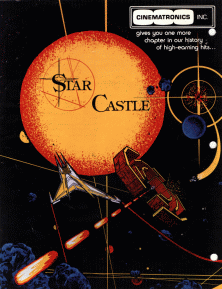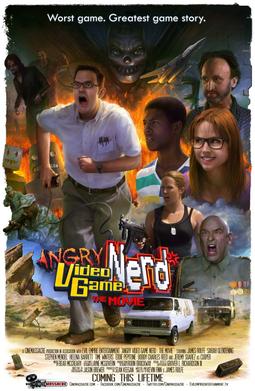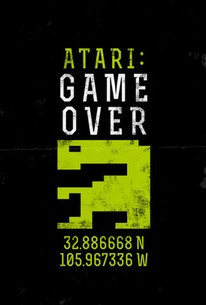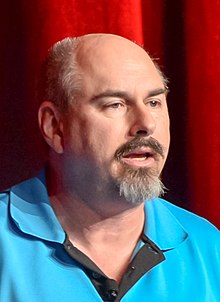
The Atari 2600 is a home video game console developed and produced by Atari, Inc. Released in September 1977 as the Atari Video Computer System, it popularized microprocessor-based hardware and games stored on swappable ROM cartridges, a format first used with the Fairchild Channel F in 1976. The VCS was bundled with two joystick controllers, a conjoined pair of paddle controllers, and a game cartridge—initially Combat and later Pac-Man. Sears sold the system as the Tele-Games Video Arcade. Atari rebranded the VCS as the Atari 2600 in November 1982 alongside the release of the Atari 5200.

E.T. the Extra-Terrestrial is a 1982 adventure video game developed and published by Atari, Inc. for the Atari 2600 and based on the film of the same name. The game's objective is to guide the eponymous character through various screens to collect three pieces of an interplanetary telephone that will allow him to contact his home planet.
A saboteur is someone who commits sabotage.

Star Raiders is a space combat simulator video game created by Doug Neubauer and published in 1980 by Atari. The player assumes the role of a starship fighter pilot, who must protect starbases from invading forces called Zylons. Piloting and combat are shown in the 3D cockpit view, while a 2D galactic map shows the state of the Zylon invasion. Neubauer made the game during in his spare time at Atari, inspired by contemporary media such as Battlestar Galactica and Star Wars, as well as the 1971 mainframe game Star Trek. Originally released on the Atari 400/800 computers, Star Raiders was later ported to the Atari 2600, Atari 5200, and Atari ST.
Alan Miller is an American video game designer who was the co-founder of the video game company Activision.

Joseph Warren Robinett Jr. is a designer of interactive computer graphics software, notable as the developer of the Atari 2600's Adventure — the first graphical adventure video game — and as a founder of The Learning Company, where he designed Rocky's Boots and Robot Odyssey. More recently he has worked on virtual reality projects.

Star Castle is a vector graphics multidirectional shooter released in arcades by Cinematronics in 1980. The game involves obliterating a series of defenses orbiting a stationary turret in the center of the screen. The display is black and white with the colors of the rings and screen provided by a transparent plastic screen overlay.
1982 was the peak year for the golden age of arcade video games as well as the second generation of video game consoles. Many games were released that would spawn franchises, or at least sequels, including Dig Dug, Pole Position, Mr. Do!, Zaxxon, Q*bert, Time Pilot and Pitfall! The year's highest-grossing video game was Namco's arcade game Pac-Man, for the third year in a row, while the year's best-selling home system was the Atari 2600. Additional video game consoles added to a crowded market, notably the ColecoVision and Atari 5200. Troubles at Atari late in the year triggered the video game crash of 1983.

The Atari Flashback series are a line of dedicated video game consoles designed, produced, published and marketed by AtGames under license from Atari SA. The Flashback consoles are "plug-and-play" versions of the Atari 2600 console. They contain built-in games rather than using the ROM cartridges utilized by the 2600. Most of the games are classics that were previously released for the 2600, although some Flashback consoles include previously unreleased prototype games as well.
Tod R. Frye is an American computer programmer once employed by Atari, Inc., and is most notable for developing the home adaptation of Pac-Man for the Atari 2600 video computer system. Following the collapse of Atari he worked at video game and computer game companies such as 3DO and Pronto Games.

Raiders of the Lost Ark is an action-adventure game for the Atari 2600 released in 1982, based on the 1981 film of the same name. The game was designed by Howard Scott Warshaw.
Raymond Edward Kassar was president, and later CEO, of Atari Inc. from 1978 to 1983. He had previously been executive vice-president of Burlington Industries, the world's largest textile company at the time, and president of its Burlington House division.

Pac-Man is a 1982 maze video game developed and published by Atari, Inc. under official license by Namco, and an adaptation of the 1980 hit arcade game of the same name. The player controls the title character, who attempts to consume all of the wafers in a maze while avoiding four ghosts that pursue him. Eating flashing wafers at the corners of the screen causes the ghosts to temporarily turn blue and flee, allowing Pac-Man to eat them for bonus points. Once eaten, a ghost is reduced to a pair of eyes, which return to the center of the maze to be restored.

The Atari video game burial was a mass burial of unsold video game cartridges, consoles, and computers in a New Mexico landfill site undertaken by the American video game and home computer company Atari, Inc. in 1983. Before 2014, the goods buried were rumored to be unsold copies of E.T. the Extra-Terrestrial (1982), one of the largest commercial video game failures and often cited as one of the worst video games ever released, and the 1982 Atari 2600 port of Pac-Man, which was commercially successful but critically maligned.

Atari, Inc. was an American video game developer and home computer company founded in 1972 by Nolan Bushnell and Ted Dabney. Atari was a key player in the formation of the video arcade and video game industry.

Yars' Revenge is a video game released for the Atari 2600 in 1982. It was created by Howard Scott Warshaw and is Atari's best-selling original game for the 2600.

Angry Video Game Nerd: The Movie is a 2014 American independent science-fiction adventure comedy film written and directed by James Rolfe and Kevin Finn. It is based on the web series of the same name, also created by Rolfe, with himself as the lead character alongside Jeremy Suarez, Sarah Glendening, Stephen Mendel, Time Winters, Helena Barrett, David Dastmalchian, Robbie Rist, and Eddie Pepitone.

Atari: Game Over is a 2014 documentary film directed by Zak Penn. It is about the Atari video game burial excavation. The film was released in 2014 by Xbox on Xbox Live.

Atari 50 is a video game compilation and interactive documentary about the history of Atari. It comprises newly shot interviews with former Atari employees, archival footage, emulated games from the company's catalog, and six new games inspired by past Atari games. It was developed by Digital Eclipse and released on Atari VCS, Nintendo Switch, PlayStation 4, PlayStation 5, Windows, Xbox One, and Xbox Series X/S in 2022, the 50th anniversary of Atari's founding. The main feature of the game is a five-part interactive timeline that lays out the history of the company and its products through video, scanned artifacts and related games.















